ESP Alfa Romeo MiTo 2013 Owner handbook (in English)
[x] Cancel search | Manufacturer: ALFA ROMEO, Model Year: 2013, Model line: MiTo, Model: Alfa Romeo MiTo 2013Pages: 312, PDF Size: 11.5 MB
Page 85 of 312
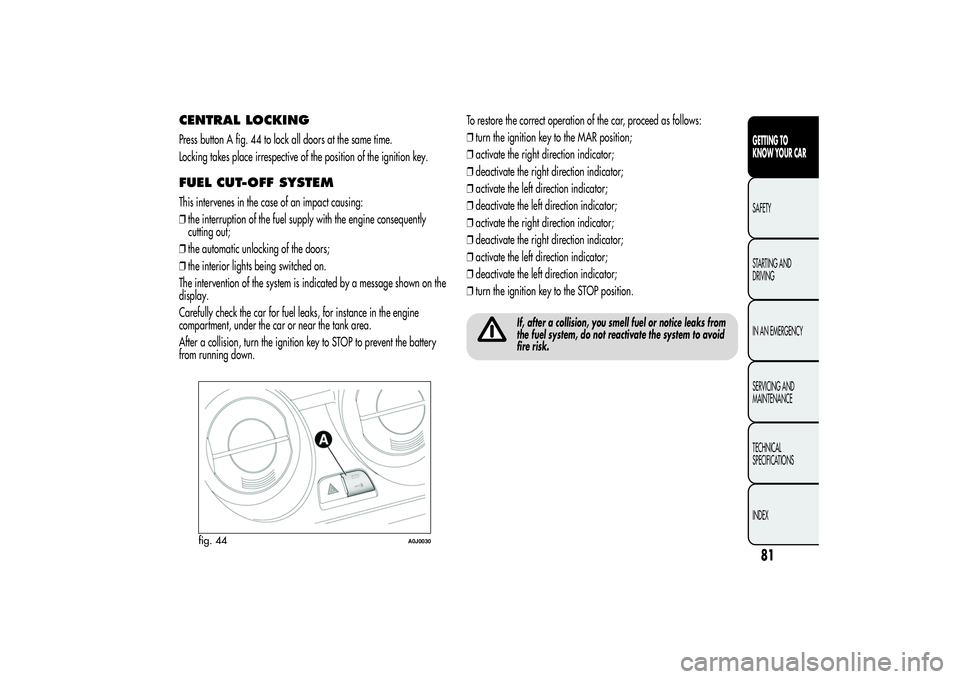
CENTRAL LOCKINGPress button A fig. 44 to lock all doors at the same time.
Locking takes place irrespective of the position of the ignition key.FUEL CUT-OFF SYSTEMThis intervenes in the case of an impact causing:
❒the interruption of the fuel supply with the engine consequently
cutting out;
❒the automatic unlocking of the doors;
❒the interior lights being switched on.
The intervention of the system is indicated by a message shown on the
display.
Carefully check the car for fuel leaks, for instance in the engine
compartment, under the car or near the tank area.
After a collision, turn the ignition key to STOP to prevent the battery
from running down.To restore the correct operation of the car, proceed as follows:
❒turn the ignition key to the MAR position;
❒activate the right direction indicator;
❒deactivate the right direction indicator;
❒activate the left direction indicator;
❒deactivate the left direction indicator;
❒activate the right direction indicator;
❒deactivate the right direction indicator;
❒activate the left direction indicator;
❒deactivate the left direction indicator;
❒turn the ignition key to the STOP position.
If, after a collision, you smell fuel or notice leaks from
the fuel system, do not reactivate the system to avoid
fire risk.
fig. 44
A0J0030
81GETTING TO
KNOW YOUR CARSAFETY
STARTING AND
DRIVING
IN AN EMERGENCY
SERVICING AND
MAINTENANCE
TECHNICAL
SPECIFICATIONS
INDEX
Page 108 of 312
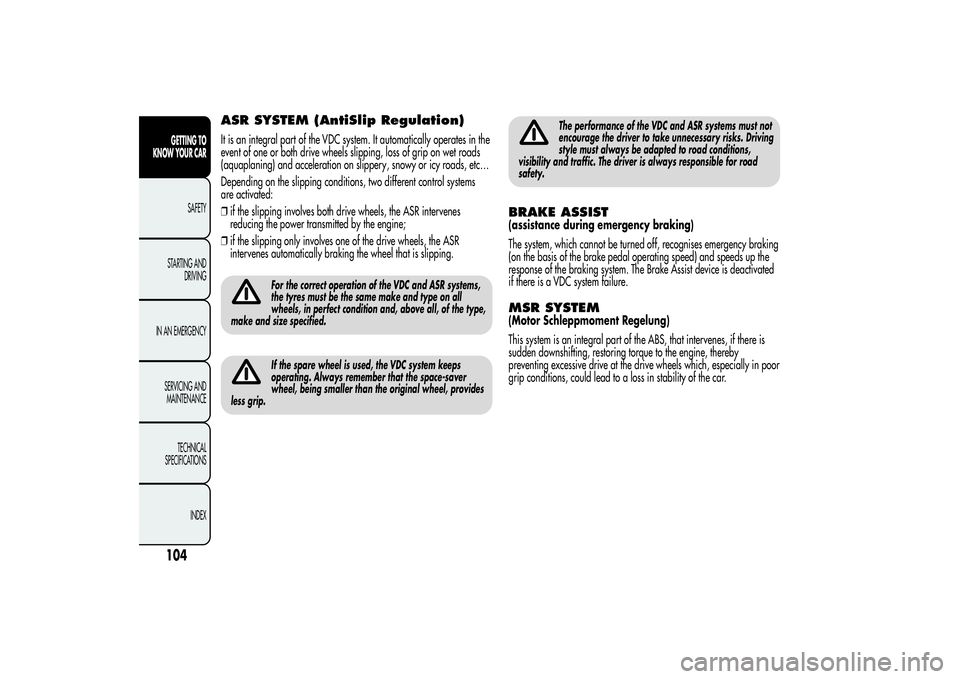
ASR SYSTEM (AntiSlip Regulation)It is an integral part of the VDC system. It automatically operates in the
event of one or both drive wheels slipping, loss of grip on wet roads
(aquaplaning) and acceleration on slippery, snowy or icy roads, etc…
Depending on the slipping conditions, two different control systems
are activated:
❒if the slipping involves both drive wheels, the ASR intervenes
reducing the power transmitted by the engine;
❒if the slipping only involves one of the drive wheels, the ASR
intervenes automatically braking the wheel that is slipping.
For the correct operation of the VDC and ASR systems,
the tyres must be the same make and type on all
wheels, in perfect condition and, above all, of the type,
make and size specified.If the spare wheel is used, the VDC system keeps
operating. Always remember that the space-saver
wheel, being smaller than the original wheel, provides
less grip.
The performance of the VDC and ASR systems must not
encourage the driver to take unnecessary risks. Driving
style must always be adapted to road conditions,
visibility and traffic. The driver is always responsible for road
safety.
BRAKE ASSIST(assistance during emergency braking)
The system, which cannot be turned off, recognises emergency braking
(on the basis of the brake pedal operating speed) and speeds up the
response of the braking system. The Brake Assist device is deactivated
if there is a VDC system failure.MSR SYSTEM(Motor Schleppmoment Regelung)
This system is an integral part of the ABS, that intervenes, if there is
sudden downshifting, restoring torque to the engine, thereby
preventing excessive drive at the drive wheels which, especially in poor
grip conditions, could lead to a loss in stability of the car.
104GETTING TO
KNOW YOUR CAR
SAFETY
STARTING AND
DRIVING
IN AN EMERGENCY
SERVICING AND
MAINTENANCE
TECHNICAL
SPECIFICATIONS
INDEX
Page 110 of 312
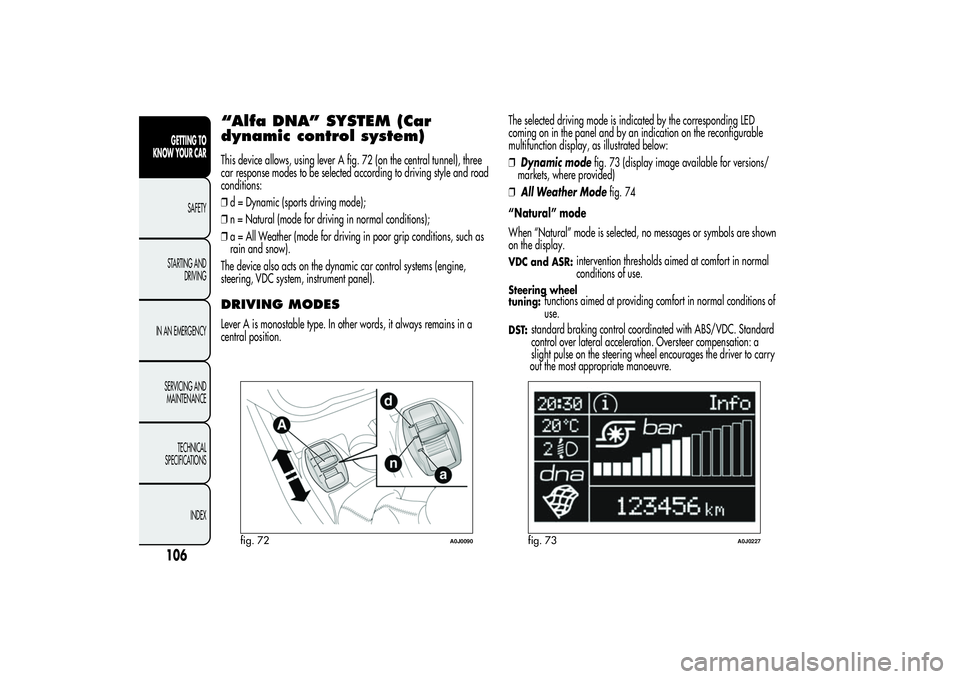
“Alfa DNA” SYSTEM (Car
dynamic control system)This device allows, using lever A fig. 72 (on the central tunnel), three
car response modes to be selected according to driving style and road
conditions:
❒d = Dynamic (sports driving mode);
❒n = Natural (mode for driving in normal conditions);
❒a = All Weather (mode for driving in poor grip conditions, such as
rain and snow).
The device also acts on the dynamic car control systems (engine,
steering, VDC system, instrument panel).DRIVING MODESLever A is monostable type. In other words, it always remains in a
central position.The selected driving mode is indicated by the corresponding LED
coming on in the panel and by an indication on the reconfigurable
multifunction display, as illustrated below:
❒Dynamic modefig. 73 (display image available for versions/
markets, where provided)
❒All Weather Modefig. 74
“Natural” mode
When “Natural” mode is selected, no messages or symbols are shown
on the display.
VDC and ASR:
intervention thresholds aimed at comfort in normal
conditions of use.
Steering wheel
tuning:
functions aimed at providing comfort in normal conditions of
use.
DST:
standard braking control coordinated with ABS/VDC. Standard
control over lateral acceleration. Oversteer compensation: a
slight pulse on the steering wheel encourages the driver to carry
fig. 72
A0J0090
fig. 73
A0J0227
106GETTING TO
KNOW YOUR CAR
SAFETY
STARTING AND
DRIVING
IN AN EMERGENCY
SERVICING AND
MAINTENANCE
TECHNICAL
SPECIFICATIONS
INDEX
out the most appropriate manoeuvre.
Page 111 of 312
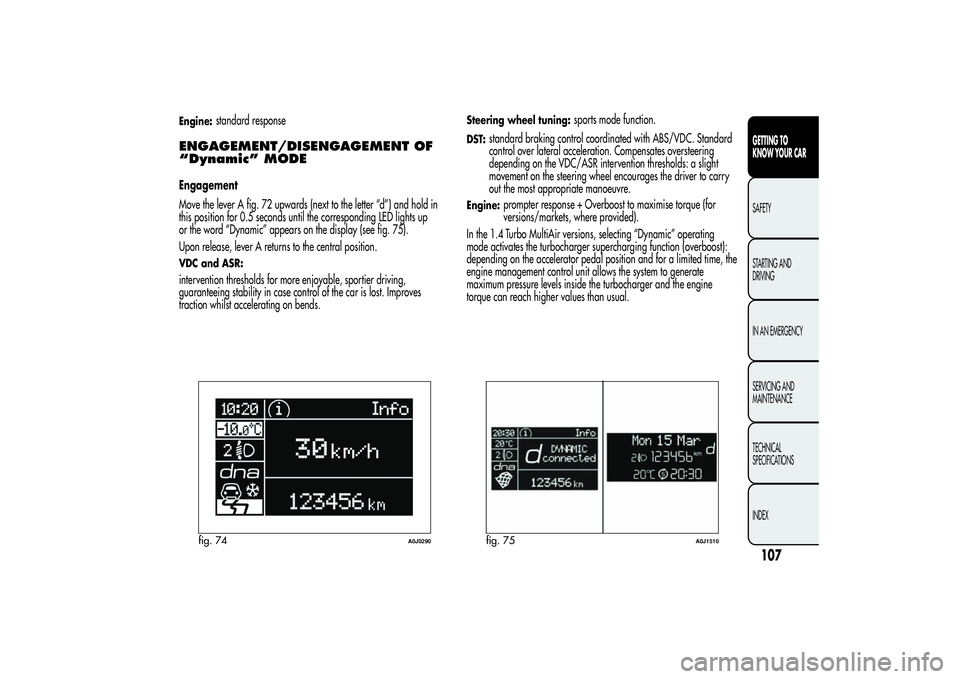
Engine:
standard response
ENGAGEMENT/DISENGAGEMENT OF
“Dynamic” MODEEngagement
Move the lever A fig. 72 upwards (next to the letter “d”) and hold in
this position for 0.5 seconds until the corresponding LED lights up
or the word “Dynamic” appears on the display (see fig. 75).
Upon release, lever A returns to the central position.VDC and ASR:intervention thresholds for more enjoyable, sportier driving,
guaranteeing stability in case control of the car is lost. Improves
traction whilst accelerating on bends.
Steering wheel
tuning:
sports mode function.
DST:
standard braking control coordinated with ABS/VDC. Standard
control over lateral acceleration. Compensates oversteering
depending on the VDC/ASR intervention thresholds: a slight
movement on the steering wheel encourages the driver to carry
out the most appropriate manoeuvre.
Engine:
prompter response + Overboost to maximise torque (for
versions/markets, where provided).
In the 1.4 Turbo MultiAir versions, selecting “Dynamic” operating
mode activates the turbocharger supercharging function (overboost):
depending on the accelerator pedal position and for a limited time, the
engine management control unit allows the system to generate
maximum pressure levels inside the turbocharger and the engine
torque can reach higher values than usual.
fig. 74
A0J0290
fig. 75
A0J1510
107GETTING TO
KNOW YOUR CARSAFETY
STARTING AND
DRIVING
IN AN EMERGENCY
SERVICING AND
MAINTENANCE
TECHNICAL
SPECIFICATIONS
INDEX
Page 112 of 312

This function is particularly useful whenever maximum performance is
required for a short time (e.g. when overtaking).
IMPORTANT During acceleration, when the “Dynamic” function is used
the steering may shudder, which is typical of a sports setting.
Disengagement
To deactivate “Dynamic” mode and return to “Natural”, repeat the
same movement of the lever within the same times. In this case, the LED
corresponding to “Natural” mode will light up and the words “Natural
on” will appear on the reconfigurable multifunction display (see fig.
76).ENGAGEMENT/DISENGAGEMENT OF
“All Weather” MODEEngagement
Move lever A fig. 72 downwards (to the letter “a”) and hold in this
position for 0.5 seconds until the corresponding LED lights up or the
word “All Weather” appears on the display (see fig. 77).
VDC and ASR:
intervention thresholds for top safety and car control
even in the event of critical road conditions (e.g. in
case of rain, snow, etc.).
Steering wheeltuning:
maximum comfort.
DST:
higher braking control coordinated with ABS/VDC. Standard
control over lateral acceleration. Compensates oversteering
depending on the VDC/ASR intervention thresholds: a slight
movement on the steering wheel encourages the driver to carry
out the most appropriate manoeuvre.
Engine:
standard response
Disengagement
To deactivate “All Weather” mode and return to “Natural”, carry out
the same procedure described for “Dynamic” mode, but move lever A
fig. 72 to “a”.
fig. 76
A0J1059
fig. 77
A0J1511
108GETTING TO
KNOW YOUR CAR
SAFETY
STARTING AND
DRIVING
IN AN EMERGENCY
SERVICING AND
MAINTENANCE
TECHNICAL
SPECIFICATIONS
INDEX
Page 114 of 312
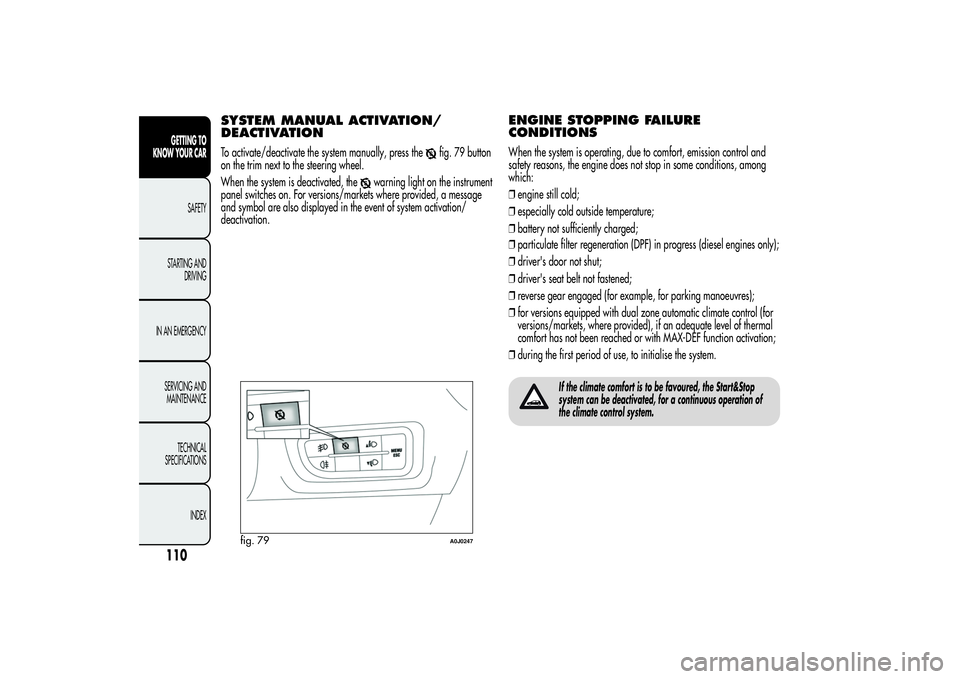
SYSTEM MANUAL ACTIVATION/
DEACTIVATIONTo activate/deactivate the system manually, press the
fig. 79 button
on the trim next to the steering wheel.
When the system is deactivated, the
warning light on the instrument
panel switches on. For versions/markets where provided, a message
and symbol are also displayed in the event of system activation/
deactivation.
ENGINE STOPPING FAILURE
CONDITIONSWhen the system is operating, due to comfort, emission control and
safety reasons, the engine does not stop in some conditions, among
which:
❒engine still cold;
❒especially cold outside temperature;
❒battery not sufficiently charged;
❒particulate filter regeneration (DPF) in progress (diesel engines only);
❒driver's door not shut;
❒driver's seat belt not fastened;
❒reverse gear engaged (for example, for parking manoeuvres);
❒for versions equipped with dual zone automatic climate control (for
versions/markets, where provided), if an adequate level of thermal
comfort has not been reached or with MAX-DEF function activation;
❒during the first period of use, to initialise the system.
If the climate comfort is to be favoured, the Start&Stop
system can be deactivated, for a continuous operation of
the climate control system.
fig. 79
A0J0247
110GETTING TO
KNOW YOUR CAR
SAFETY
STARTING AND
DRIVING
IN AN EMERGENCY
SERVICING AND
MAINTENANCE
TECHNICAL
SPECIFICATIONS
INDEX
Page 117 of 312

Before opening the bonnet, make sure the engine is off and
the ignition key is in the STOP position. Follow the
indications on the plate underneath the bonnet fig. 82. It is
advisable to extract the key when there are other people in the car.
Leave the car only after having removed the ignition key or having
turned it to STOP. During refuelling, make sure that the engine is off
and that the ignition key is in the STOP position.
DYNAMIC SUSPENSION (active
shock absorber system)(for versions/markets, where provided)
This system interacts with the “Alfa DNA” system (see paragraph “Alfa
DNA”).
The “Alfa DNA” system lever allows you to choose three different
driving settings depending on the route type and on the road surface:
❒d = Dynamic (sports driving mode);
❒n = Natural (mode for driving in normal conditions);
❒a = All Weather (mode for driving in poor grip conditions, such as
rain and snow).
In “Natural” and “All Weather” operating mode, the active shock
absorbers adjust the car suspension to suit the route type and
the driving stresses, thus considerably improving driving comfort in
particular on rough terrain.
The "Dynamic" operating mode produces a sports driving setting
characterised by more responsive acceleration and greater effort on
the steering wheel to give a sporty feeling. The shock absorber
damping action is also adjusted and divided, to guarantee higher
precision and reactivity of the car, while maintaining a good comfort
level.
The car is more precise when entering bends and quicker in changing
direction.
fig. 82
A0J0341
113GETTING TO
KNOW YOUR CARSAFETY
STARTING AND
DRIVING
IN AN EMERGENCY
SERVICING AND
MAINTENANCE
TECHNICAL
SPECIFICATIONS
INDEX
Page 118 of 312

EOBD SYSTEM (European On
Board Diagnosis)(for versions/markets, where provided)
The aim of the EOBD system (European On Board Diagnosis) is to:
❒monitor the system efficiency;
❒indicate an increase in emissions;
❒indicate the need to replace damaged components.
The car also has a diagnostic connector that can be interfaced with
appropriate tools, which makes it possible to read the error codes
stored in the electronic control units together with a series of specific
parameters for engine operation and diagnosis. This check can also be
carried out by the traffic police.
IMPORTANT After eliminating a fault, to check the system completely,
Alfa Romeo Authorised Services are obliged to run tests and, if
necessary, road tests which may also call for a long journey.
ELECTRIC POWER STEERINGThis only operates with the key turned to MAR-ON and the engine
started. Power steering allows the force required at the steering wheel
to be adapted to driving conditions.
The different power assistance modes can be selected via the "d,n,a"
positions of the “Alfa DNA System” lever (see “Alfa DNA System”
paragraph).
It is absolutely forbidden to carry out any after-market
operation involving steering system or steering column
modifications (e.g.: installation of anti-theft device)
that could badly affect performance and safety, invalidate the
warranty and also result in non-compliance of the car with
type-approval requirements.Before performing any maintenance operations,
always turn off the engine and remove the key from
the ignition to lock the steering column, especially
when the car’s wheels are not touching the ground.
114GETTING TO
KNOW YOUR CAR
SAFETY
STARTING AND
DRIVING
IN AN EMERGENCY
SERVICING AND
MAINTENANCE
TECHNICAL
SPECIFICATIONS
INDEX
Page 122 of 312

Detection distances
❒Central operating range: 140 cm
❒Side operating range: 60 cm
If several obstacles are detected by the sensors, only the nearest one is
considered.OPERATION WITH TRAILERParking sensor operation is deactivated automatically when the trailer
electric cable plug is fitted into the car tow hook socket. The sensors
are automatically enabled again when the trailer's cable plug is
removed.
The sensor must be free of mud, dirt, snow or ice in order
for the system to work. Be careful not to scratch or damage
the sensors while cleaning them. Avoid using dry, rough
or hard cloths. The sensors should be washed using clean water with
the addition of car shampoo if necessary. When using special washing
equipment such as high pressure jets or steam cleaning, clean the
sensors very quickly keeping the jet more than 10 cm away.When repainting the bumpers or touching up paint in
the sensor area, contact Alfa Romeo Authorized
Services only. Incorrect paint application could affect
the operation of the parking sensors.
Parking manoeuvres however are always the driver’s
responsibility. When carrying out such manoeuvres,
always ensure that the manoeuvring area is free of
people (particularly children) and animals. The parking sensor is
designed to assist drivers, who must still never allow their
attention to lapse during potentially dangerous manoeuvres even
if performed at low speed.
GENERAL WARNINGSDuring parking manoeuvres, pay the utmost attention to any obstacles
that could be located above or below the sensors.
Objects located near the rear of the car are not detected under certain
circumstances and could therefore cause damage to the car or be
damaged.
The following conditions may influence the performance of the parking
sensor system:
❒reduced sensor sensitivity and a reduction in the parking assistance
system performance could be due to the presence on the surface of
the sensor of: ice, snow, mud, thick paint
❒the sensors may detect a non-existent obstacle (echo interference)
due to mechanical interference, for example when washing the
car, in rain (strong wind), hail;
❒The signals sent by the sensors can also be altered by the presence
of ultrasonic systems (e.g. pneumatic brake systems or pneumatic
drills) near the vehicle.
118GETTING TO
KNOW YOUR CAR
SAFETY
STARTING AND
DRIVING
IN AN EMERGENCY
SERVICING AND
MAINTENANCE
TECHNICAL
SPECIFICATIONS
INDEX
Page 136 of 312
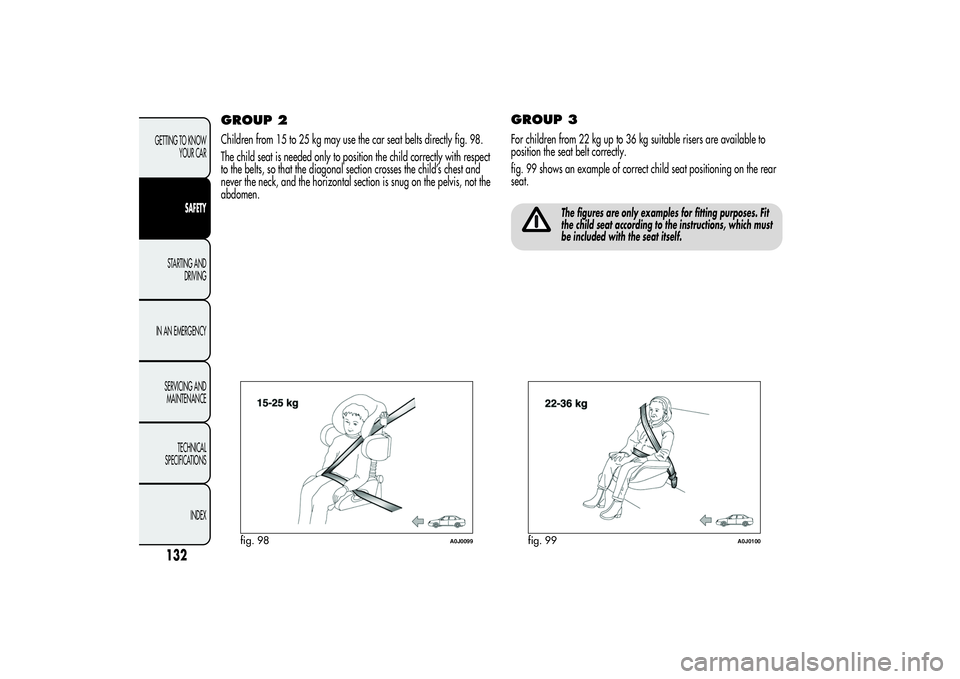
GROUP 2Children from 15 to 25 kg may use the car seat belts directly fig. 98.
The child seat is needed only to position the child correctly with respect
to the belts, so that the diagonal section crosses the child’s chest and
never the neck, and the horizontal section is snug on the pelvis, not the
abdomen.
GROUP 3For children from 22 kg up to 36 kg suitable risers are available to
position the seat belt correctly.
fig. 99 shows an example of correct child seat positioning on the rear
seat.
The figures are only examples for fitting purposes. Fit
the child seat according to the instructions, which must
be included with the seat itself.
fig. 98
A0J0099
fig. 99
A0J0100
132GETTING TO KNOW
YOUR CAR
SAFETY
STARTING AND
DRIVING
IN AN EMERGENCY
SERVICING AND
MAINTENANCE
TECHNICAL
SPECIFICATIONS
INDEX